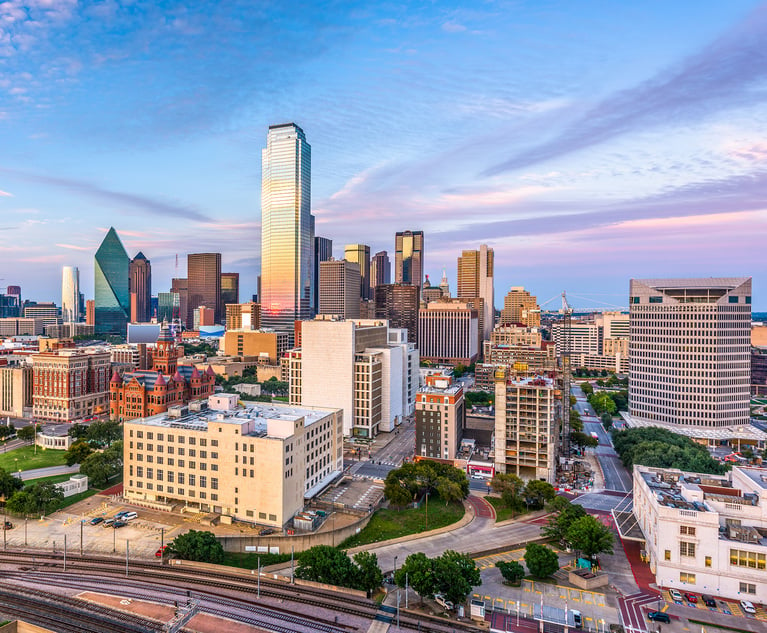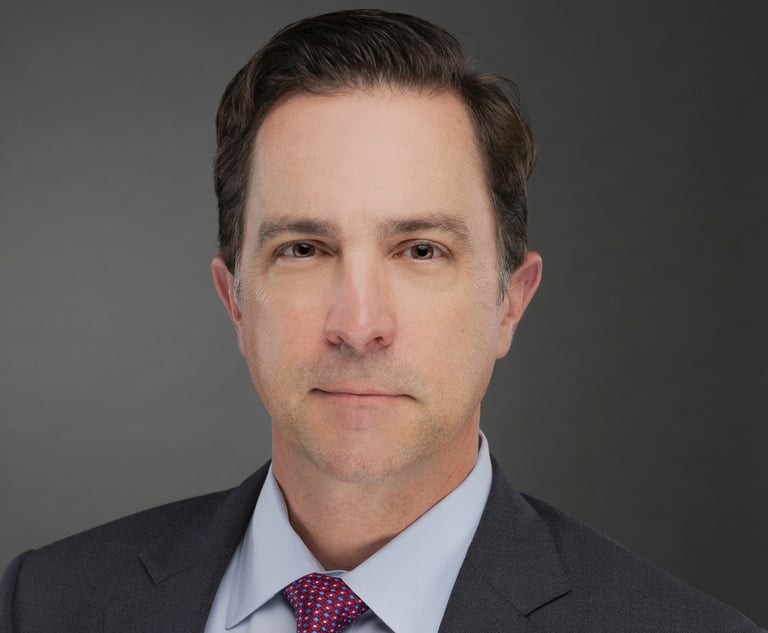The Jury and the Screen: Judges, Lawyers Reflect on Texas' Experimental Zoom Jury Trial
"I can't think of any other time---other than a global pandemic---that we would be able to make that happen that quickly," Judge Emily Miskel said.
May 20, 2020 at 05:07 PM
5 minute read
 Photo: Shutterstock.com
Photo: Shutterstock.com
Dual computer screens.
It's a change that San Antonio litigator Michael Pearson plans for the next time he conducts a jury trial using Zoom.
Pearson, the plaintiffs attorney who participated in Monday's first experiment using video conferencing for a jury trial, explained that it was difficult to multitask on one screen.
"I was having to do everything on my laptop, and that was tough," said Pearson, founder of Pearson Legal, who represented a plaintiff in an insurance dispute who was doing a summary jury trial, which is an alternative dispute resolution proceeding involving a one-day trial, nonbinding jury verdict and mediation.
At the same time he had to examine his witnesses, present his Powerpoint and exhibits—that was the predominant window on screen—while also keeping his eye on the 12 jurors whose videos were little or sometimes hidden on screen.
"I would figure out something that would be more elaborate. For example, I would have one screen constantly on the 12 jurors. I would have another screen on the witness, judge, opposing counsel," Pearson said. "I would have my paralegal log into Zoom and have her run the PowerPoint and exhibits. I would be sitting next to her, but she would be on her own computer. I would ask, 'Can you pull up exhibit two?' "
Amy Stewart, who represented the defendant in the case, didn't return a call or email seeking comment before deadline.
Because jury trials have been canceled across the United States since March because of the COVID-19 outbreak, many attorneys and judges closely watched the Lone Star State's experiment Monday. Many believed it was the first jury trial in the nation to happen over video conferencing.
Judge Emily Miskel of Collin County's 470th District Court planned for the Zoom trial for a month and ran the tech side of the proceeding. She explained that the Texas Supreme Court wanted to experiment with a jury trial over video conference, as a potential solution for the court backlog that the coronavirus shutdown has created. Texas Office of Court Administration director David Slayton recruited Miskel for the experiment, Miskel said.
" I was spending my whole month grilling anyone I could find," Miskel said. "I can't think of any other time—other than a global pandemic–that we would be able to make that happen that quickly."
Rapport with jurors
During jury selection, Pearson, the plaintiffs attorney, used Zoom's gallery view, where he could see each potential juror.
"When I was questioning them, you could see their nonverbal reactions, and you could begin to establish a rapport with those jurors," said Pearson.
The people were in comfortable clothes and on their own turf. It seemed they opened up better, he said.
"When you are in a courtroom, it's an unfamiliar setting to jurors, and they are less likely to come out of their shells and answer. Here, you had everyone in their homes," Pearson said. "The feedback was more natural."
He said he would use Zoom again for a nonbinding summary jury trial in a heartbeat.
But he added, "I'm not ready to agree to do it on a full-blown trial that could last one to two weeks and end in a binding verdict from the jury."
Senior Judge Keith Dean, the mediator assigned to the case who presided over the summary jury trial, said he could imagine a hybrid system: using Zoom for jury selection and an in-person proceeding for the trial.
"At this point, who knows where we are going to be in the coronavirus situation a month from now, or six weeks from now? I think Zoom translates very easily to jury selection, where bringing 400 people down to sit in the central jury room, and bringing 50 of them into the courtroom—there is no way from a logistical standpoint to make it work," Dean said.
But once a six- or 12-member jury was picked for a case, the courts would have to figure out how to protect them from infection while doing an in-person trial, Dean added.
Miskel added that before courts can use video conferencing for jury trials, they need to remember that jury panels must reflect the whole community—and yet not everyone has equal access to computers and Internet. Also, the jurors in this trial needed technical help during their deliberations, which Miskel took care of by entering their Zoom breakout room.
For a real Zoom trial, there would need to be a high-tech bailiff who could help jurors but still preserve the jury room environment, she said.
"That's what they physically do in the courthouse," Miskel explained. "We just need to have that equivalent for the 21st Century."
This content has been archived. It is available through our partners, LexisNexis® and Bloomberg Law.
To view this content, please continue to their sites.
Not a Lexis Subscriber?
Subscribe Now
Not a Bloomberg Law Subscriber?
Subscribe Now
NOT FOR REPRINT
© 2025 ALM Global, LLC, All Rights Reserved. Request academic re-use from www.copyright.com. All other uses, submit a request to [email protected]. For more information visit Asset & Logo Licensing.
You Might Like
View All
JCPenney Seeks Return of More Than $1.1M From Jackson Walker For Bankruptcy Work
3 minute read
Ex-Appellate Court Judges Launch Boutique Focused on Plaintiffs Appeals
2 minute read
O'Melveny, White & Case, Skadden Beef Up in Texas With Energy, Real Estate Lateral Partner Hires
5 minute read
Chamberlain Hrdlicka Taps a New Leader as Firm Follows Succession Planning Path
3 minute readTrending Stories
- 1Uber Files RICO Suit Against Plaintiff-Side Firms Alleging Fraudulent Injury Claims
- 2The Law Firm Disrupted: Scrutinizing the Elephant More Than the Mouse
- 3Inherent Diminished Value Damages Unavailable to 3rd-Party Claimants, Court Says
- 4Pa. Defense Firm Sued by Client Over Ex-Eagles Player's $43.5M Med Mal Win
- 5Losses Mount at Morris Manning, but Departing Ex-Chair Stays Bullish About His Old Firm's Future
Who Got The Work
J. Brugh Lower of Gibbons has entered an appearance for industrial equipment supplier Devco Corporation in a pending trademark infringement lawsuit. The suit, accusing the defendant of selling knock-off Graco products, was filed Dec. 18 in New Jersey District Court by Rivkin Radler on behalf of Graco Inc. and Graco Minnesota. The case, assigned to U.S. District Judge Zahid N. Quraishi, is 3:24-cv-11294, Graco Inc. et al v. Devco Corporation.
Who Got The Work
Rebecca Maller-Stein and Kent A. Yalowitz of Arnold & Porter Kaye Scholer have entered their appearances for Hanaco Venture Capital and its executives, Lior Prosor and David Frankel, in a pending securities lawsuit. The action, filed on Dec. 24 in New York Southern District Court by Zell, Aron & Co. on behalf of Goldeneye Advisors, accuses the defendants of negligently and fraudulently managing the plaintiff's $1 million investment. The case, assigned to U.S. District Judge Vernon S. Broderick, is 1:24-cv-09918, Goldeneye Advisors, LLC v. Hanaco Venture Capital, Ltd. et al.
Who Got The Work
Attorneys from A&O Shearman has stepped in as defense counsel for Toronto-Dominion Bank and other defendants in a pending securities class action. The suit, filed Dec. 11 in New York Southern District Court by Bleichmar Fonti & Auld, accuses the defendants of concealing the bank's 'pervasive' deficiencies in regards to its compliance with the Bank Secrecy Act and the quality of its anti-money laundering controls. The case, assigned to U.S. District Judge Arun Subramanian, is 1:24-cv-09445, Gonzalez v. The Toronto-Dominion Bank et al.
Who Got The Work
Crown Castle International, a Pennsylvania company providing shared communications infrastructure, has turned to Luke D. Wolf of Gordon Rees Scully Mansukhani to fend off a pending breach-of-contract lawsuit. The court action, filed Nov. 25 in Michigan Eastern District Court by Hooper Hathaway PC on behalf of The Town Residences LLC, accuses Crown Castle of failing to transfer approximately $30,000 in utility payments from T-Mobile in breach of a roof-top lease and assignment agreement. The case, assigned to U.S. District Judge Susan K. Declercq, is 2:24-cv-13131, The Town Residences LLC v. T-Mobile US, Inc. et al.
Who Got The Work
Wilfred P. Coronato and Daniel M. Schwartz of McCarter & English have stepped in as defense counsel to Electrolux Home Products Inc. in a pending product liability lawsuit. The court action, filed Nov. 26 in New York Eastern District Court by Poulos Lopiccolo PC and Nagel Rice LLP on behalf of David Stern, alleges that the defendant's refrigerators’ drawers and shelving repeatedly break and fall apart within months after purchase. The case, assigned to U.S. District Judge Joan M. Azrack, is 2:24-cv-08204, Stern v. Electrolux Home Products, Inc.
Featured Firms
Law Offices of Gary Martin Hays & Associates, P.C.
(470) 294-1674
Law Offices of Mark E. Salomone
(857) 444-6468
Smith & Hassler
(713) 739-1250






